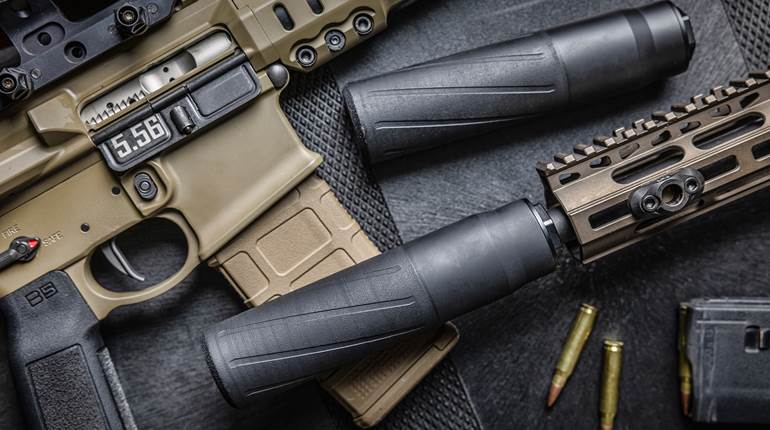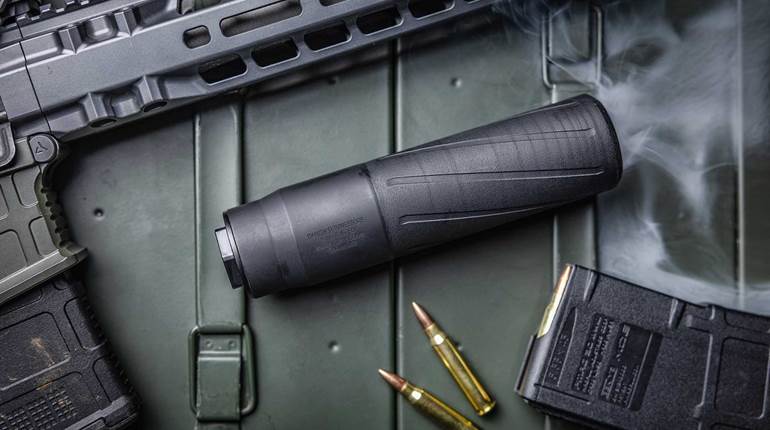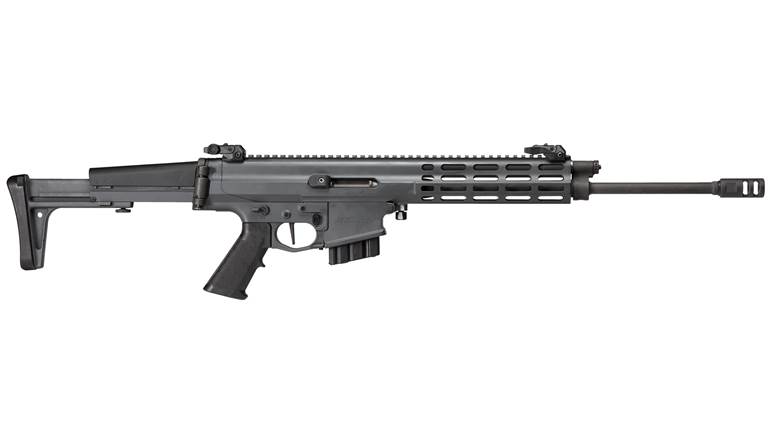
In 2018, the U.S. Air Force adopted the GAU-5A Aircrew Self Defense Weapon. This modified AR-15 platform was developed by the Air Force Custom Gun Shop for use by combat pilots who are forced to eject from their aircraft behind enemy lines. Chambered in 5.56 NATO/.223 Rem., the GAU-5A carbine's 12.5" barrel has an effective range of approximately 200 meters (218.7 yards), and it accepts standard-capacity 30-round magazines. This makes it a much more flexible defensive option when compared to typical military sidearms, including the M9 or M17 pistols.
 This company takes pride in its customer service and preparing QRB system orders to ship the same day they are placed.
This company takes pride in its customer service and preparing QRB system orders to ship the same day they are placed.
But the primary challenge of arming pilots with a carbine instead of a pistol was storage inside the limited interior space of a bail-out survival bag, which in turn must fit into the ejection seat of a fighter jet. Air Force gunsmiths adopted the Cry Havoc Tactical QRB system as a key component of their takedown carbine solution.
 This complete QRB kit is configured for use with AR-15 platforms chambered for rifle rounds. In this case, it was tested with a .300 BLK pistol.
This complete QRB kit is configured for use with AR-15 platforms chambered for rifle rounds. In this case, it was tested with a .300 BLK pistol.
Developed and patented by Michael Selvetti, QRB stands for Quick Release Barrel. This system provides the means to remove an AR barrel, along with the handguard and gas system, from the upper receiver as a single unit. This can be done without separating the upper and lower receivers from each other or removing the bolt assembly. Jim Lane, who is now the CEO of Cry Havoc Tactical, was so taken by this product's rugged construction and reliability that he went to work for the company and eventually purchased the patent. He made a few improvements to the design, leading to the release of the Gen 3 version of the system, which is the subject of this conversation.
 Customers specify in their orders the two-part gas-tube length they will need for their configuration.
Customers specify in their orders the two-part gas-tube length they will need for their configuration.
The QRB kit consists of a barrel plate, upper-receiver plate, star nut, a receiver-alignment pin, handguard spacer and a proprietary two-piece gas system. For blowback operated, pistol-caliber platforms, the gas system components are replaced with a plug. In this case, the AR-15 and AR-10 kits tested were both configured for gas-impingement actions.
 The AR-10 QRB plates (l.) are slightly thicker than the AR-15 set (r.).
The AR-10 QRB plates (l.) are slightly thicker than the AR-15 set (r.).
The rounded, 2.45" diameter aluminum plates are treated with a matte-black hard-coat anodized finish. The upper-receiver plate is secured in place by the provided star nut and supports the shorter portion of the gas system. The barrel plate supports the handguard and the section of the gas tube connected to the gas block. When ordering the QRB system, the customer needs to specify the appropriate tube length based on the gas block position.
The plate is secured to the barrel using three hex-head screws set between two latches that can be adjusted for tension using a hex wrench. With both plates installed, the handguard will be pushed forward from the receiver about 1.5" with the AR-15 Kit and around 1.75" with the AR-10 kit. So it's a good idea to measure and verify if the handguard you have will still fit or if it will need to be traded out for a shorter unit.
 Shown above is a top-down view of the AR-10 QRB system with the barrel installed and latched in place.
Shown above is a top-down view of the AR-10 QRB system with the barrel installed and latched in place.
It's interesting to note that the QRB system was originally intended for civilian use and then adopted by the military. For many firearm-related products, it’s the other way around. The AR-15 1-Pin version, as one might guess, has a single round-pin extension located directly above the end of the gas tube. Because this pin is slightly longer, it protects the tube from impact and aids in proper alignment.
The military version of the AR-15 kit has two pins, one at 12 o'clock and the other at roughly the 5 o'clock position. This second pin works to 'idiot proof' the system for quicker barrel installation under less-than-ideal conditions. The only difference between the one-pin and two-pin configurations is that second pin. The AR-10 kits are only available in a two-pin version with both pins located to the right and left of the gas tube. This pin configuration works to prevent an AR-15 barrel from unintentionally being fitted into an AR-10 upper.
 The barrel plate latches are released by pulling the tabs towards the receivers.
The barrel plate latches are released by pulling the tabs towards the receivers.
To remove the barrel with the QRB system installed, begin by removing the magazine and verifying the AR is completely unloaded. With the gun pointed in a safe direction, lock the bolt carrier back into the open position. Release the right and left side barrel plate latches and ensure the latch hooks swing free of the receiver plate. Pull the barrel out of the receiver, and the process is complete. It’s just that simple. Applying a light coating of lubricant to the exterior of the barrel extension is important to ease its transition in and out of the receiver.
 With the latches released, the barrel assembly is pulled forward off the upper receiver.
With the latches released, the barrel assembly is pulled forward off the upper receiver.
When reinstalling the barrel, it's helpful to tip the barrel down so that the latches fall forward. Twisting the barrel back and forth slightly helps it to slide into place. Close the latches, and the AR is ready to be loaded and fired. The process of removing or replacing the barrel takes about 15 seconds without hurrying, once someone is familiar with the system.
 The QRB AR-10-barrel plate (l.) compared to the AR-15 two-pin plate.
The QRB AR-10-barrel plate (l.) compared to the AR-15 two-pin plate.
In evaluating the QRB system for the GAU-5A, the Air Force team eventually assembled a dozen test guns, each of which was fired for 1,500 rounds. During the evaluation, the gun’s barrels were repeatedly removed and reinstalled. The final accuracy scores showed consistent sub-m.o.a. results. I was similarly satisfied with the QRB's performance and reliability when I incorporated it into a AR-10 pattern .308 Win. pistol build and a compact AR-15 .300 BLK takedown pistol (Note that these pistols, which also incorporate stabilizing braces, were built and tested well before the 2023 ATF rulings regarding the use of braces with AR-type handguns).

Cry Havoc Tactical's QRB system is a great fit for building or converting existing AR pistols, carbines or rifles into takedown guns. The company sells complete kits or just barrel plates for those who want to use the system for quick caliber conversions or for changing barrel lengths. With suggested retail prices from $400 to $450, this system has three things going for it that justify the investment: it works, it works well, and it's easy to use. For more information, visit cryhavoctac.com.























![Winchester Comm[94]](/media/1mleusmd/winchester-comm-94.jpg?anchor=center&mode=crop&width=770&height=430&rnd=134090756537800000&quality=60)
![Winchester Comm[94]](/media/1mleusmd/winchester-comm-94.jpg?anchor=center&mode=crop&width=150&height=150&rnd=134090756537800000&quality=60)











